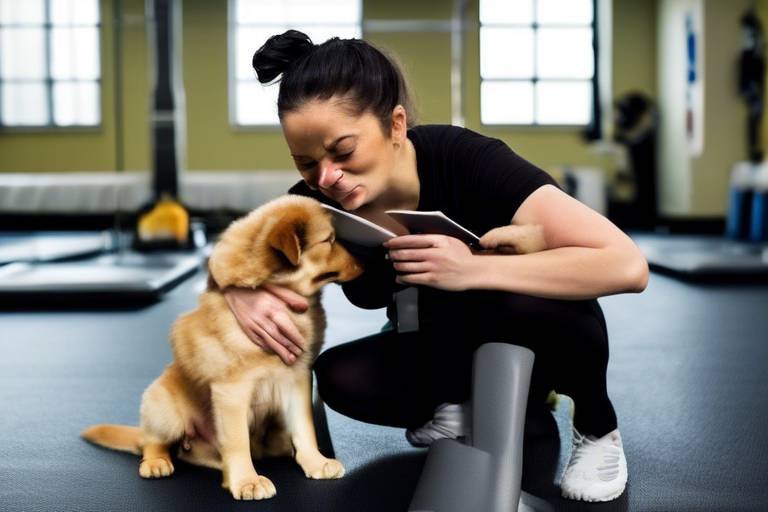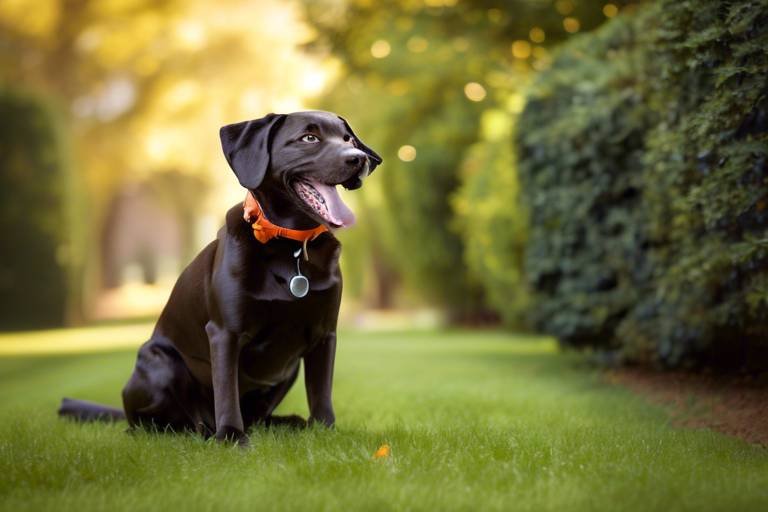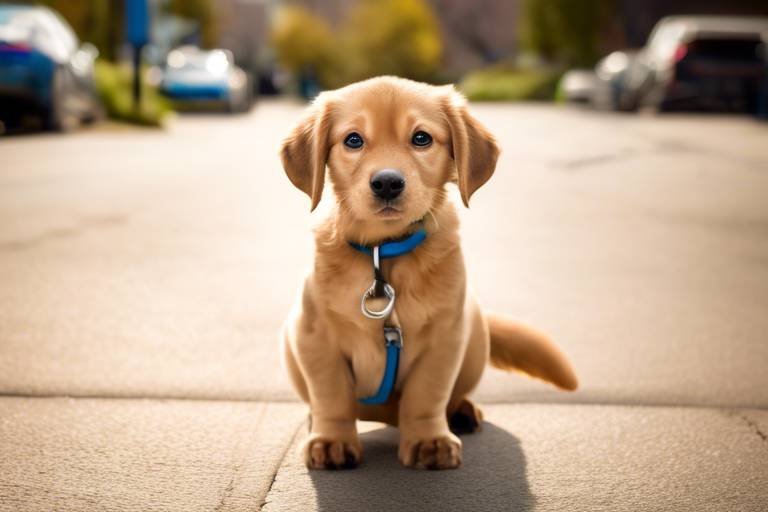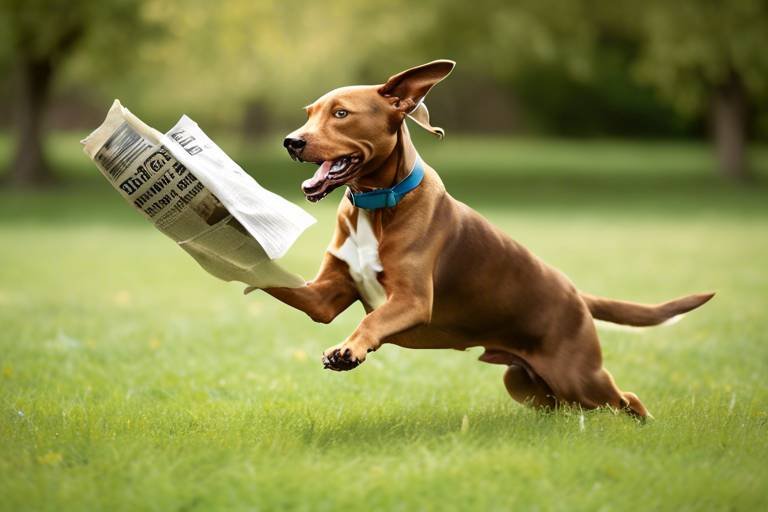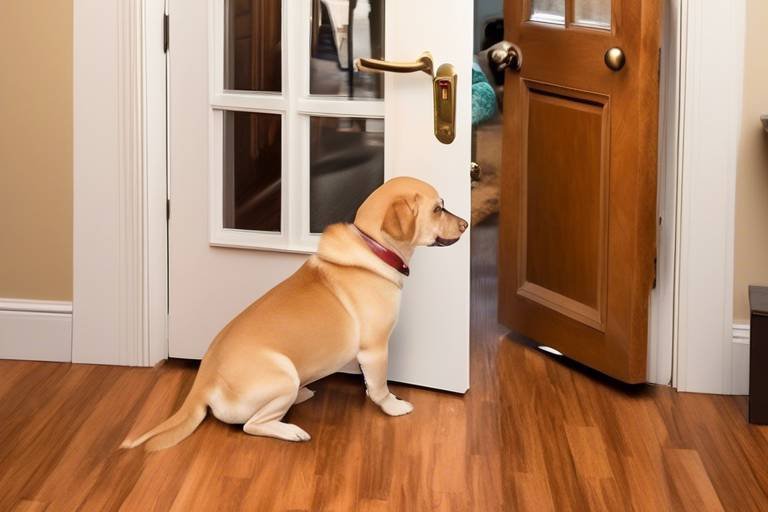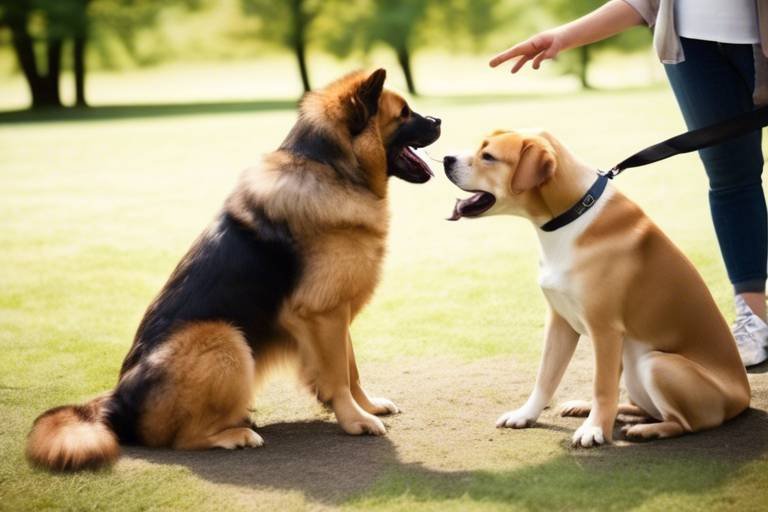How to Help Your Dog Overcome Fear of Thunder
Does your furry friend turn into a trembling mess when thunder rolls in? You're not alone! Many dog owners face the challenge of helping their pets cope with the fear of thunderstorms. Understanding how to effectively assist your pup can make a world of difference in their comfort and well-being. In this article, we will dive deep into various strategies and techniques to help your dog manage their anxiety during storms. By the end, you'll be equipped with the knowledge to transform those terrifying stormy nights into a more peaceful experience for both you and your beloved companion.
First things first, let's talk about how dogs express fear. Just like humans, dogs can exhibit a range of behaviors when they feel anxious or scared. Some common signs include panting, pacing, hiding, barking, or even destructive behavior. Recognizing these signs is crucial because it allows you to intervene effectively when a thunderstorm hits. Think of it this way: if you were in a dark room and suddenly heard a loud noise, your instinct would be to find a safe spot. Your dog feels the same way! By understanding their fear responses, you can better support them through the storm.
One of the most effective ways to help your dog during thunderstorms is to create a designated safe space in your home. This area should be a quiet and cozy retreat where your dog can feel secure. Imagine a little sanctuary filled with their favorite things; it can work wonders in alleviating anxiety. To set up this safe space, consider the following:
- Choose a location that's away from windows and loud noises.
- Include familiar items like blankets, toys, or even your old shirt to provide comfort.
- Make it a cozy nook with plenty of soft bedding.
By establishing this safe haven, you're giving your dog a place to retreat when the thunder starts rumbling. It’s like building a fortress against the storm!
When selecting the location for your dog's safe space, think about areas in your home that are naturally quieter. Basements or interior rooms can be ideal since they tend to be insulated from the outdoor noise. Avoid places near windows where the sound of thunder can be amplified. It’s all about creating a bubble of tranquility amidst the chaos of a storm.
Incorporating your dog's favorite comfort items into their safe space can significantly help ease their anxiety. Just like a child might cling to a stuffed animal during a storm, dogs can find solace in their beloved toys or blankets. These items carry their scent and provide a sense of familiarity, which can be incredibly soothing. So, don’t hesitate to create a little nest of comfort for your pup!
To further enhance your dog's safe space, consider implementing some soundproofing techniques. Closing windows, drawing heavy curtains, or even playing white noise can help drown out the thunder. Think of it as adding extra layers of protection to their fortress. The goal is to create a peaceful environment where your dog can relax and feel secure.
Another effective approach is desensitization and counter-conditioning. This involves gradually exposing your dog to the sound of thunder in a controlled environment. Start by playing recorded thunder sounds at a very low volume, and reward your dog for staying calm. Over time, increase the volume as they become more comfortable. It’s a bit like training for a marathon; you wouldn’t start by running 26 miles, right? Gradual exposure helps build their confidence and resilience.
Now, let’s talk about the power of positive reinforcement. This technique can dramatically change your dog's emotional response to thunder. By rewarding calm behavior during storms, you help your dog associate thunder with positive experiences. Think of it as turning a scary monster into a friendly giant! Use treats, praise, or playtime as rewards when your dog remains calm during a storm.
Incorporating treats during thunderstorm training can reinforce desired behaviors. For instance, if your dog stays in their safe space during a thunderstorm, shower them with praise and a tasty treat. This not only encourages them to remain calm but also builds their confidence in handling their fear of thunder. It's a win-win situation!
Finally, don't overlook the various calming products available on the market. From anxiety wraps to pheromone diffusers and calming music playlists, these products can provide additional support for your fearful pet. They work like a soothing balm for anxious minds, helping your dog feel more at ease during storms. Experiment with different options to see what works best for your furry friend.
Q: What should I do if my dog has severe anxiety during thunderstorms?
A: If your dog's anxiety is severe, consult with a veterinarian or a professional dog trainer. They may recommend behavioral therapy or medication to help manage the fear.
Q: How long does it take for a dog to overcome their fear of thunder?
A: Every dog is different, but with consistent training and support, many dogs can show improvement in a few weeks to months.
Q: Are there any specific breeds that are more prone to thunder anxiety?
A: While any dog can develop a fear of thunder, some breeds, particularly those that are more sensitive or have a strong bond with their owners, may be more prone to anxiety.

Understanding Canine Fear Responses
When it comes to our furry friends, understanding their emotions is key to helping them navigate through challenging situations. Fear in dogs can manifest in various ways, and recognizing these signs is crucial for effective intervention, especially during thunderstorms. Just like humans, dogs experience fear, but their ways of expressing it can be quite different. Some dogs may cower and hide, while others might bark excessively or even try to escape. It's essential to pay attention to your dog's unique responses to fear, as this will guide you in providing the best support.
Dogs often communicate their fear through body language. For instance, a dog that is scared may exhibit signs such as:
- Tail Tucking: A dog might tuck its tail between its legs, signaling submission or fear.
- Shaking or Trembling: Physical reactions like shaking can indicate high anxiety levels.
- Whining or Barking: Vocalizations can be a way for dogs to express their distress.
- Avoidance Behavior: Some dogs may try to hide or escape from the source of their fear.
Understanding that each dog is unique is vital. Just as some humans might cope with fear by talking it out, others might prefer solitude. Similarly, your dog might seek comfort from you, or it may retreat to a safe, quiet place. This variability in response means that what works for one dog might not be effective for another. Therefore, it’s important to observe and learn what calms your specific dog during stressful situations.
Moreover, the context of the fear can play a significant role. For example, a dog that has previously experienced a traumatic event during a thunderstorm may develop a heightened sensitivity to thunder sounds. This can lead to a cycle of fear that becomes increasingly difficult to break. Understanding this background can help you tailor your approach. Are there specific triggers that cause your dog to react more intensely? Identifying these can be the first step in helping your dog cope.
In conclusion, recognizing and understanding canine fear responses is not just about observing behavior; it’s about creating a bond of trust with your pet. By being attentive and responsive to their needs, you can help them feel safe and secure during storms. Remember, patience is key. Just like a child learning to cope with their fears, your dog will need time to adjust and learn that storms don’t have to be scary.
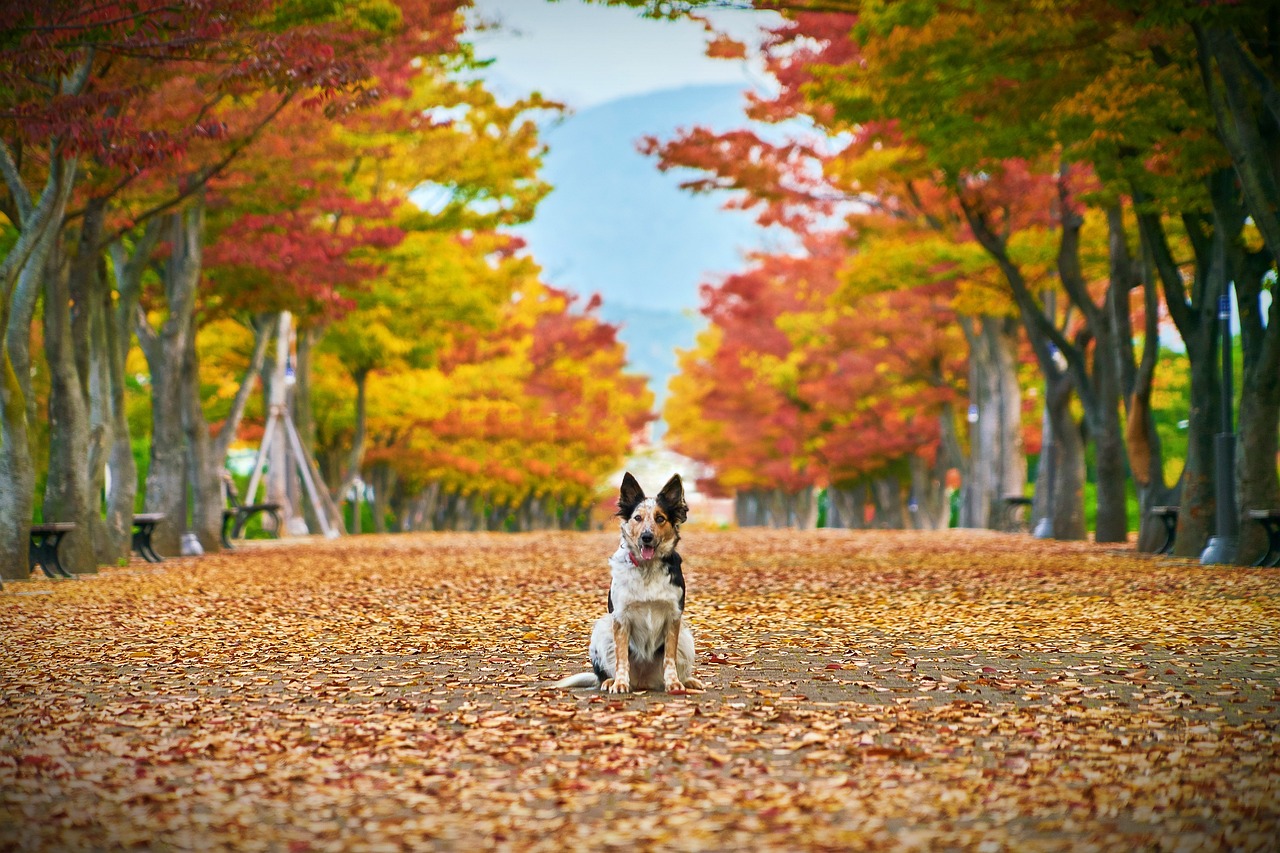
Creating a Safe Space
When it comes to helping your furry friend cope with their fear of thunder, one of the most effective strategies is to create a safe space in your home. This designated area serves as a sanctuary where your dog can retreat during storms, providing them with a sense of security and comfort. Imagine it as a cozy hideaway, much like a child’s fort, where they can feel protected from the chaos outside. The key to setting up this space is to make it quiet, cozy, and filled with familiar items that can help soothe their anxiety.
First and foremost, you need to choose the right location for this safe space. Ideally, it should be situated in a part of your home that is away from windows and any loud noises. Think of it as finding the perfect nook in a library—somewhere peaceful where distractions are minimal. Basements or interior rooms can be excellent choices, as they often provide a buffer from the booming thunder and flashing lightning. The goal is to create an environment that feels secure and calm for your dog.
Once you've identified the location, the next step is to fill this space with your dog's favorite comfort items. These could include their beloved blankets, toys, or even a piece of your clothing. Just like how you might snuggle up with a favorite pillow during a storm, your dog will benefit from having familiar scents and textures around them. These comfort items act as a security blanket, helping to alleviate anxiety and promote relaxation. You might even consider creating a little nest for them, layering blankets and pillows to make it extra inviting.
Another crucial aspect of creating a safe space is implementing soundproofing techniques. While it’s impossible to eliminate the sound of thunder entirely, you can certainly minimize it. Start by closing all windows and doors to block out the noise. Heavy curtains can also be a game-changer; they not only help to muffle sound but also create a darker environment that can be soothing for your dog. Think of it as building a fortress against the storm—one that keeps the noise at bay and provides a sense of calm.
In addition to these techniques, you might want to consider using white noise machines or calming music to drown out the thunder. Just as some people find comfort in background noise while studying or sleeping, your dog may find solace in gentle sounds that mask the thunder's roar. This multi-faceted approach to creating a safe space can significantly improve your dog's experience during storms, transforming what once was a terrifying ordeal into a more manageable situation.
Choosing the Right Location
When it comes to helping your dog cope with the fear of thunder, selecting the right location for their safe space is absolutely crucial. Think of it as creating a cozy little sanctuary where your furry friend can retreat during storms. Ideally, this space should be tucked away in a part of your home that minimizes exposure to the chaos outside. Rooms that are far from windows and doors are often best, as they can significantly dampen the noise of thunder and the sight of flashing lightning. Imagine how comforting it would feel to be wrapped in a warm blanket, away from the storm's fury!
It's also important to consider the overall ambiance of the chosen area. A quiet corner of your home, perhaps in a basement or an interior room, can provide a sense of security. You might want to avoid high-traffic areas where loud footsteps and other noises could add to your dog's anxiety. Instead, look for a peaceful nook that feels safe and secluded. If you have a small room or a cozy closet, these can serve as perfect hideaways for your pup.
Additionally, think about the temperature and ventilation of the space. A cool, well-ventilated area can help your dog feel more comfortable, especially if the storm brings hot, humid weather. You might even want to consider using a fan or air conditioning to create a calm atmosphere. Remember, the goal is to make this space a haven where your dog can feel relaxed and secure, away from the storm's overwhelming sights and sounds.
Here are a few tips to keep in mind when choosing the right location:
- Distance from windows: Ensure the space is far away from windows to reduce visual stimuli.
- Low noise levels: Pick a room that is less likely to have disturbances from household activities.
- Comfortable environment: Make sure the area is cozy with soft bedding and familiar scents.
- Accessibility: Choose a location that your dog can easily access, especially during a storm.
Ultimately, the right location should feel like a safe retreat for your dog, allowing them to weather the storm with as little stress as possible. By thoughtfully selecting and preparing this space, you can help your furry friend feel more secure and less anxious during those thunderous nights.
Using Comfort Items
When it comes to helping your dog feel secure during thunderstorms, comfort items can play a pivotal role. Think of these items as a warm hug on a cold day; they provide a sense of security and familiarity that can help ease your pup's anxiety. Dogs are creatures of habit, and having their favorite belongings around can make a world of difference. So, what should you include in your dog's safe space?
First and foremost, consider incorporating your dog's favorite blankets or beds. The texture and smell of their personal bedding can create a cozy atmosphere that feels like home. If your dog has a specific blanket they love to snuggle with, make sure it's in their designated safe area. The warmth and comfort of familiar fabrics can help calm their nerves.
Next, don't underestimate the power of toys. Whether it's a squeaky toy, a plush companion, or even a chew toy, having something to focus on can distract your dog from the booming thunder. It’s like giving them a little piece of joy amidst the storm. Additionally, consider including items that carry your scent, such as an old t-shirt or a piece of your clothing. Your scent can be incredibly soothing to your dog, reminding them that they are safe and loved.
Another great option is to use calming sprays or pheromone diffusers in conjunction with comfort items. These products can create a serene environment that can significantly reduce anxiety levels. Just as a calming fragrance can help us unwind, these scents can have a similar effect on our furry friends. Pairing these products with their favorite comfort items can create a multi-sensory safe haven for your dog during thunderstorms.
Finally, it’s essential to regularly rotate these comfort items to keep the experience fresh and engaging. Just like we enjoy new things, your dog might appreciate a change in their comfort items every now and then. This can also prevent them from becoming overly reliant on just one item, which can be beneficial in the long run.
In summary, using comfort items is a simple yet effective strategy to help dogs cope with their fear of thunder. By providing familiar blankets, toys, and even your scent, you can create a safe space that promotes relaxation and security. Remember, the goal is to make your dog feel as comfortable as possible, allowing them to weather the storm with confidence.
- What are the best comfort items to use for my dog during thunderstorms?
Some of the best comfort items include your dog's favorite blankets, toys, and items that carry your scent, like old clothing.
- How can I create a safe space for my dog?
Choose a quiet area away from windows, fill it with comfort items, and consider adding calming products like pheromone diffusers.
- Is it normal for dogs to be afraid of thunder?
Yes, many dogs experience fear during thunderstorms due to the loud noises and changes in atmospheric pressure.
- Can I train my dog to be less afraid of thunder?
Yes, techniques like desensitization and positive reinforcement can help your dog build confidence and reduce their fear over time.
Soundproofing Techniques
When it comes to helping your furry friend cope with the terrifying sounds of thunder, can be a game-changer. Think of it as creating a cozy little fortress where your dog can feel safe and sound, away from the booming chaos outside. One of the first steps you can take is to close all windows and doors. This simple action can significantly reduce the volume of thunder and other loud noises that might send your pup into a panic.
Next, consider using heavy curtains or soundproof drapes. Not only do they add a touch of elegance to your home, but they also act as a barrier against sound. By blocking out the noise, you create a more serene environment for your dog. If you're feeling particularly crafty, you might even want to invest in acoustic panels that can be mounted on walls to absorb sound waves. These panels are often used in music studios, but they can work wonders in creating a peaceful retreat for your pet.
Another effective method is to use rugs or carpets on the floor. Hard surfaces can amplify sounds, so adding soft materials can help muffle the noise. If your dog has a favorite blanket, consider laying it down in their safe space. Not only will it provide comfort, but it will also help to dampen the sounds from outside. Here's a quick summary of soundproofing techniques:
| Technique | Description |
|---|---|
| Close Windows and Doors | Minimizes external noise from entering the home. |
| Heavy Curtains | Blocks sound and adds a cozy atmosphere. |
| Acoustic Panels | Absorbs sound waves to reduce noise levels. |
| Rugs or Carpets | Dampens sound on hard surfaces, creating a softer environment. |
Finally, don't underestimate the power of white noise machines or calming music. These can drown out the sound of thunder and create a soothing ambiance that helps your dog relax. You might find that playing soft music or nature sounds can be incredibly effective. Just remember, each dog is unique, so it may take some experimentation to find the right combination of techniques that works for your furry friend.
- How can I tell if my dog is afraid of thunder? Look for signs such as trembling, hiding, excessive barking, or attempts to escape. If your dog seems unusually anxious during storms, they may have a fear of thunder.
- Are there specific products that can help? Yes! Products like anxiety wraps, pheromone diffusers, and calming music can provide additional support during thunderstorms.
- What if my dog doesn't respond to soundproofing techniques? If your dog continues to show signs of fear, consider consulting with a veterinarian or a professional dog trainer for additional strategies.
Desensitization and Counter-Conditioning
Desensitization and counter-conditioning are two powerful techniques that can significantly help your dog manage their fear of thunder. Think of desensitization as slowly introducing your dog to the scary sound of thunder in a controlled way. Instead of playing a loud thunderstorm recording that might send your pup into a panic, you start with something much softer. This gradual exposure allows your dog to become accustomed to the sound without feeling overwhelmed. It’s like dipping your toes into a cold pool instead of jumping in all at once!
To implement this technique effectively, you can follow a simple plan:
- Step 1: Begin with a recording of thunder at a very low volume, one that your dog can barely hear.
- Step 2: While the recording plays, engage your dog in a fun activity, such as playing with their favorite toy or practicing some simple commands. This helps create a positive association with the sound.
- Step 3: Gradually increase the volume over several sessions, always ensuring your dog remains relaxed and comfortable. If they show signs of stress, reduce the volume back to a level where they are at ease.
- Step 4: Continue this process until your dog can remain calm at a volume that mimics a real thunderstorm.
Counter-conditioning complements desensitization by changing your dog’s emotional response to thunder. Instead of associating the sound with fear, you want them to associate it with something positive. This could be treats, praise, or playtime. For example, whenever the thunder sound plays, follow it up with a treat or their favorite activity. Over time, your dog will start to look forward to the sound of thunder, expecting good things to come their way instead of feeling anxious.
It’s important to be patient during this process. Each dog is unique, and some may take longer than others to adjust. Regular practice, along with plenty of love and encouragement, can make a world of difference. Remember, the goal is to create a safe learning environment where your dog feels secure and supported.
Q: How long does it take for desensitization and counter-conditioning to work?
A: The time frame varies depending on the dog. Some may show improvement in just a few sessions, while others may take weeks or even months. Consistency is key!
Q: Can I use these techniques for other fears my dog may have?
A: Absolutely! Desensitization and counter-conditioning can be effective for various fears, including loud noises, new environments, or unfamiliar people.
Q: Should I consult a professional trainer?
A: If you find that your dog’s fear is severe or if you’re unsure about how to proceed, seeking the help of a professional dog trainer or behaviorist can be very beneficial.

Positive Reinforcement Strategies
When it comes to helping your furry friend overcome their fear of thunder, positive reinforcement is a game-changer. This method is all about rewarding your dog for calm behavior during storms, which helps them associate thunder with positive experiences rather than fear. Think of it like training a child; when they do something good, you give them a treat or praise, which encourages them to repeat that behavior. In the same way, rewarding your dog for staying calm can gradually shift their emotional response to the sound of thunder.
One effective approach to positive reinforcement is to set up a training routine that coincides with stormy weather. For instance, you can prepare treats that your dog loves and keep them handy. When a thunderstorm hits, and your dog manages to stay calm, even if it’s just for a moment, shower them with praise and a tasty treat. This not only reinforces their calm behavior but also builds their confidence over time. It's like giving them a little pat on the back every time they face their fears!
Incorporating calming products into your training can further enhance the effectiveness of positive reinforcement. For example, using an anxiety wrap or pheromone diffuser while rewarding your dog can create a soothing environment, making it easier for them to remain calm. You might find that combining these products with treats helps your dog feel more secure and less anxious during a storm.
To illustrate how positive reinforcement can work, consider the following table that outlines a simple training plan:
| Step | Action | Reward |
|---|---|---|
| 1 | Play recorded thunder sounds at a low volume. | Give treats for calm behavior. |
| 2 | Gradually increase the volume over several sessions. | Continue rewarding with praise and treats. |
| 3 | Introduce thunder sounds during a storm. | Reward calmness with favorite toys or treats. |
It's important to remember that every dog is unique, and the time it takes for them to adjust will vary. Some dogs may respond quickly to positive reinforcement, while others might need more time and patience. The key is to remain consistent and patient throughout the process. You might even consider keeping a journal to track your dog's progress. This way, you can celebrate the small victories along the way and adjust your approach as necessary.
Lastly, always keep an eye on your dog's body language. If they seem overwhelmed, it’s okay to take a step back and reduce the intensity of the training. The goal is to create a safe and supportive environment where your dog feels secure. With love, patience, and positive reinforcement, you can help your dog learn to cope with their fear of thunder, turning stormy nights into peaceful ones!
- How long does it take for a dog to overcome fear of thunder?
It varies by dog; some may improve in a few sessions, while others may take weeks or months. - Can I use medication alongside positive reinforcement?
Yes, consult your veterinarian for options that can complement your training. - What if my dog never seems to calm down?
Consider seeking help from a professional dog trainer or a veterinary behaviorist.
Training with Treats
Training your dog with treats during thunderstorms is a powerful way to help them build confidence and change their emotional response to thunder. Imagine your dog as a little sponge, soaking up experiences and emotions; when you reward them with treats during a storm, you’re essentially teaching them that there’s nothing to fear. It’s all about creating a positive association with what they perceive as a scary event. By consistently rewarding calm behavior, you can shift their focus from the thunder outside to the tasty reward they receive for staying calm.
To start, choose a selection of your dog's favorite treats. This might include crunchy biscuits or soft, chewy snacks—whatever gets their tail wagging! The key is to have something that your dog absolutely loves, as this will help reinforce the behavior you want to encourage. During a storm, keep the treats close at hand. As soon as you notice your dog exhibiting calm behavior, such as lying down or not barking, immediately reward them with a treat. This instant reinforcement helps them make the connection that being calm leads to good things.
Consistency is crucial in this training process. You might find it helpful to create a simple training schedule. For example, you could designate a specific time each day to practice with your dog, even when there’s no thunder. During these sessions, play recorded thunder sounds at a low volume while rewarding your dog for remaining calm. Gradually increase the volume over time, always rewarding calm behavior. This technique not only helps your dog get used to the sound of thunder but also strengthens your bond as they learn to trust you as their protector.
Here’s a quick guide to help you get started:
- Choose High-Value Treats: Use treats your dog loves to make the training effective.
- Start Small: Begin with low-volume thunder sounds and reward calmness.
- Be Consistent: Practice regularly to reinforce the behavior you want.
- Stay Calm Yourself: Your dog can sense your anxiety, so stay relaxed during training.
Remember, patience is key. It might take some time for your dog to adjust, and that’s perfectly okay. Celebrate small victories along the way, and don’t hesitate to consult a professional trainer if you feel stuck. With love, patience, and the right approach, you can help your furry friend feel more secure during those thunderous storms!
Q: How long does it take for a dog to overcome their fear of thunder?
A: The time it takes can vary greatly depending on the individual dog and the consistency of training. Some dogs may show improvement in a few weeks, while others may take several months.
Q: Are there specific treats recommended for training during thunderstorms?
A: While any treat your dog enjoys can work, soft treats are often easier to use during training since they can be consumed quickly and are highly motivating.
Q: Can I combine training with other calming methods?
A: Absolutely! Using calming products such as anxiety wraps or pheromone diffusers alongside treat training can enhance your dog’s comfort and help them feel more secure.
Utilizing Calming Products
When it comes to helping your furry friend cope with their fear of thunder, calming products can be a game changer. Just like we might reach for a cozy blanket or a warm cup of tea during a storm, our dogs can benefit from similar comforts. There’s a range of products designed specifically to soothe anxious pets, and incorporating them into your dog's routine can make a significant difference during those thunderous nights.
One popular option is the anxiety wrap, which provides gentle, constant pressure, mimicking the feeling of a hug. This can be incredibly reassuring for dogs, helping to ease their anxiety. Think of it as a soothing embrace that can help your pet feel more secure. These wraps come in various sizes and styles, so it's essential to choose one that fits your dog comfortably.
Another effective tool is pheromone diffusers. These products release synthetic versions of the calming pheromones that mother dogs produce to comfort their puppies. Setting up a diffuser in your dog's safe space can create a more tranquil atmosphere, allowing them to relax more easily during storms. You can think of it as creating a peaceful bubble where your dog can feel safe and sound.
Additionally, calming music has gained popularity among pet owners. There are specific playlists and albums designed to soothe anxious dogs, featuring soft melodies and gentle sounds. Playing this type of music during a storm can help drown out the noise of thunder and provide a calming background that helps your dog feel less alone in their fear. Just imagine how comforting it is to have a soft symphony playing in the background while the storm rages outside!
While these products can be incredibly helpful, it’s essential to remember that every dog is unique. What works wonders for one might not have the same effect on another. Therefore, it’s a good idea to experiment with different calming solutions to find the best fit for your pup. You can also consult with your veterinarian for recommendations tailored to your dog's specific needs.
In conclusion, utilizing calming products is an effective way to help your dog manage their fear of thunder. By providing comfort through anxiety wraps, pheromone diffusers, and calming music, you can create a supportive environment that promotes relaxation and security during storms.
- What are anxiety wraps, and how do they work? Anxiety wraps apply gentle pressure to a dog's body, which can help reduce anxiety by providing a sense of security.
- Are pheromone diffusers safe for dogs? Yes, pheromone diffusers are safe and can be beneficial in creating a calming environment for anxious dogs.
- Can calming music really help my dog? Absolutely! Calming music can help drown out thunder sounds and create a peaceful atmosphere, making it easier for your dog to relax.
- How do I know which calming product is right for my dog? It’s best to try different products and see which one your dog responds to positively. Consulting your veterinarian can also provide personalized recommendations.
Frequently Asked Questions
- What are the common signs that my dog is afraid of thunder?
Dogs can exhibit various signs of fear during thunderstorms, including trembling, hiding, barking, whining, or even attempting to escape. If you notice your dog seeking shelter in a corner or under furniture, it’s a clear indication that they are feeling anxious.
- How can I create a safe space for my dog during storms?
To create a safe space, choose a quiet area in your home away from windows and loud noises. Make it cozy with your dog's favorite blankets, toys, or even an item of your clothing to provide comfort. This familiar environment can help soothe their anxiety during thunderstorms.
- Is desensitization effective for helping dogs with thunder phobia?
Yes, desensitization can be very effective! By gradually exposing your dog to recorded thunder sounds at low volumes, you can help them adjust to the noise. Slowly increasing the volume as they become more comfortable can lead to a significant reduction in their fear response.
- What role does positive reinforcement play in training my dog?
Positive reinforcement is essential in helping your dog associate thunderstorms with positive experiences. By rewarding calm behavior with treats or praise during storms, you encourage your dog to remain relaxed, making it easier for them to cope with their fear.
- Are there any calming products that can help my dog?
Absolutely! There are various calming products available, such as anxiety wraps, pheromone diffusers, and calming music. These products can significantly reduce your dog's anxiety during storms and provide additional support in your training efforts.



